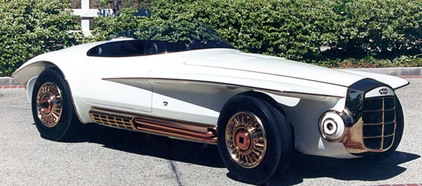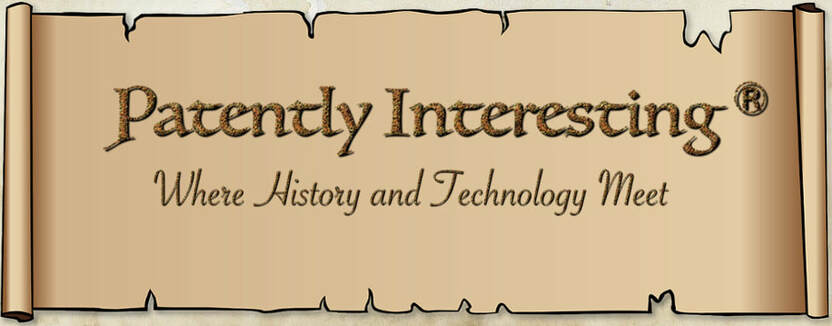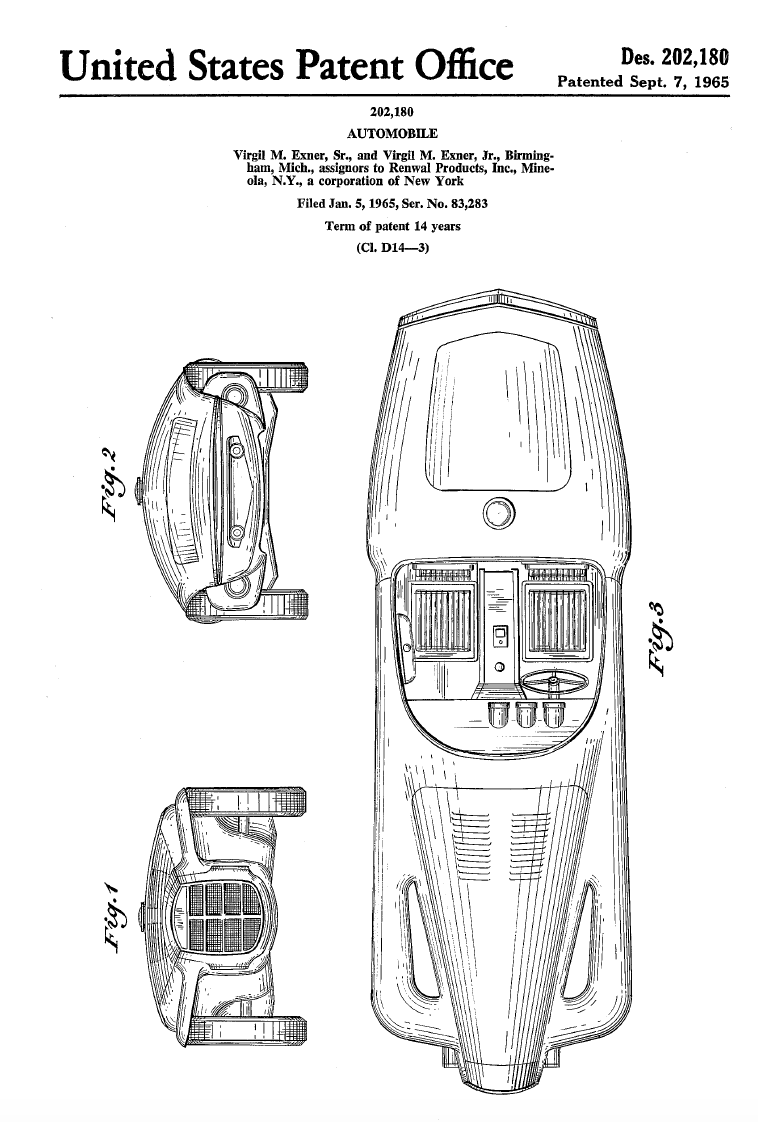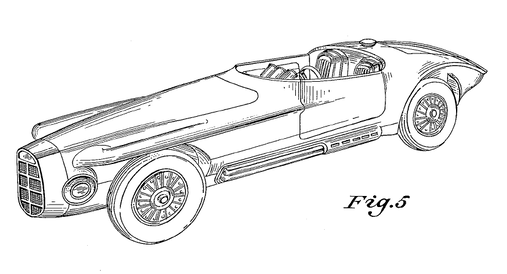
On September 7, 1965, U.S. Design Patent No.: Des. 202,180 issued to Virgil M. Exner, Sr. and Virgil M. Exner, Jr. and was assigned to Renwal Products, Inc. The design of the patent was for what has become known as the "Mercer Cobra", which is considered one of the most beautiful cars ever built.
The story of the design for the Mercer Cobra begins with Diana Bartley, who was a well-known automotive writer in the 1950s and 1960s. Bartley approached the highly regarded automotive designer Virgil M. Exner, Sr. about creating modern versions of famous automobiles of the past. Exner, Sr. had recently retired as Vice President of Design from Chrysler and had started his own design consultancy firm with his son, Virgil M. Exner, Jr. The Exners embraced Bartley's idea and created modern interpretations of four famous automobiles: the Stutz Super Bearcat, the Dusenberg Dual Cowl Sport Phaeton, the Packard Convertible Victoria and the Mercer Raceabout. These designs were featured in an article written by Bartley for the December 1963 edition of Esquiremagazine and have since become known as the Exner Revival Cars. The Exners later added modern interpretations of Bugatti, Pierce-Arrow and Jordan automobiles.
Bartley's 1963 Esquire article attracted quite a bit of attention from automotive enthusiasts. Soon after it was published, the Exners were approached by Renwal Products, Inc., which was a manufacturer of plastic model cars. The Exners and Renwal worked out a deal by which Renwal manufactured and sold plastic model kits of the four original Exner Revival Cars and the three later revival designs. These model kits were marketed as the "Revivals by Renwal" and were hugely popular with teenage model makers in the mid to late 1960s. As noted above, Renwal owned the '180 design patent for the Mercer Cobra.
Even before they were approached by Renwal, the Exners were contacted by the Copper Development Association (CDA), who wanted the Exners to build a Mercer Cobra as a display car to demonstrate the use of copper and copper alloys in trim and other automotive applications. The Exners agreed and proceeded to contact the coachbuilders Carrozzeria Ghia and Carrozzeria Sibona-Basano, who were both located in Turin, Italy. After obtaining competitive bids from the two Italian coachmakers, the Exners selected Sibona-Basano to build the body for the Mercer Cobra. Sibona-Basano had been recommended by fellow automotive designer Brooks Stevens and had submitted a much more competitive bid.
By now, the reader must be wondering where the "Cobra" in "Mercer Cobra" came from. Well, it came from Carroll Shelby, who provided the Exners with an AC Cobra chassis, engine and gearbox, which were shipped directly to Sibona-Basano in Italy. Sibona-Basano lengthened the chassis by 18 inches and built the body directly on top. While the chassis and body were made from steel, copper and its alloys were used throughout the car. In fact, more than eleven different copper alloys (including brass and bronze) were used to demonstrate the versatility of copper.
Copper and its alloys were used for the disk brakes, the brake lines, the radiator shell, the front grill, the muffler, the wheelcovers and the trim for the engine and body, including the interior cockpit. One of the most distinctive features of the Mercer-Cobra, the headlights, had bronze trim.
The headlights each had a clamshell type of construction, with a fixed inner shell and a pivotable outer shell that contained the headlamp. When not in use, the inner and outer shells were closed together, against the body. When in use, the outer shells would pivot outward ninety degrees so that the headlamps were directed forwardly.
When completed in late 1964, the Mercer-Cobra toured the world to promote copper and its alloys. The CDA retained ownership of the car for ten years and then sold it to a collector. The car has been resold several times since then. Most recently, in 2011, the Mercer-Cobra was sold at auction for $660,000.
The story of the design for the Mercer Cobra begins with Diana Bartley, who was a well-known automotive writer in the 1950s and 1960s. Bartley approached the highly regarded automotive designer Virgil M. Exner, Sr. about creating modern versions of famous automobiles of the past. Exner, Sr. had recently retired as Vice President of Design from Chrysler and had started his own design consultancy firm with his son, Virgil M. Exner, Jr. The Exners embraced Bartley's idea and created modern interpretations of four famous automobiles: the Stutz Super Bearcat, the Dusenberg Dual Cowl Sport Phaeton, the Packard Convertible Victoria and the Mercer Raceabout. These designs were featured in an article written by Bartley for the December 1963 edition of Esquiremagazine and have since become known as the Exner Revival Cars. The Exners later added modern interpretations of Bugatti, Pierce-Arrow and Jordan automobiles.
Bartley's 1963 Esquire article attracted quite a bit of attention from automotive enthusiasts. Soon after it was published, the Exners were approached by Renwal Products, Inc., which was a manufacturer of plastic model cars. The Exners and Renwal worked out a deal by which Renwal manufactured and sold plastic model kits of the four original Exner Revival Cars and the three later revival designs. These model kits were marketed as the "Revivals by Renwal" and were hugely popular with teenage model makers in the mid to late 1960s. As noted above, Renwal owned the '180 design patent for the Mercer Cobra.
Even before they were approached by Renwal, the Exners were contacted by the Copper Development Association (CDA), who wanted the Exners to build a Mercer Cobra as a display car to demonstrate the use of copper and copper alloys in trim and other automotive applications. The Exners agreed and proceeded to contact the coachbuilders Carrozzeria Ghia and Carrozzeria Sibona-Basano, who were both located in Turin, Italy. After obtaining competitive bids from the two Italian coachmakers, the Exners selected Sibona-Basano to build the body for the Mercer Cobra. Sibona-Basano had been recommended by fellow automotive designer Brooks Stevens and had submitted a much more competitive bid.
By now, the reader must be wondering where the "Cobra" in "Mercer Cobra" came from. Well, it came from Carroll Shelby, who provided the Exners with an AC Cobra chassis, engine and gearbox, which were shipped directly to Sibona-Basano in Italy. Sibona-Basano lengthened the chassis by 18 inches and built the body directly on top. While the chassis and body were made from steel, copper and its alloys were used throughout the car. In fact, more than eleven different copper alloys (including brass and bronze) were used to demonstrate the versatility of copper.
Copper and its alloys were used for the disk brakes, the brake lines, the radiator shell, the front grill, the muffler, the wheelcovers and the trim for the engine and body, including the interior cockpit. One of the most distinctive features of the Mercer-Cobra, the headlights, had bronze trim.
The headlights each had a clamshell type of construction, with a fixed inner shell and a pivotable outer shell that contained the headlamp. When not in use, the inner and outer shells were closed together, against the body. When in use, the outer shells would pivot outward ninety degrees so that the headlamps were directed forwardly.
When completed in late 1964, the Mercer-Cobra toured the world to promote copper and its alloys. The CDA retained ownership of the car for ten years and then sold it to a collector. The car has been resold several times since then. Most recently, in 2011, the Mercer-Cobra was sold at auction for $660,000.



